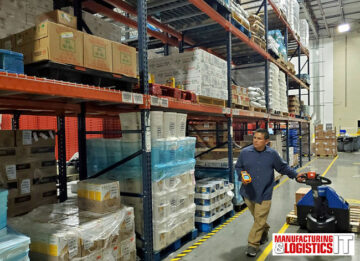By Jason McLean, freelance writer.
Since the supply chain crisis went global, many who weren’t familiar with the industry began wondering what it was all about. That kind of knowledge vacuum usually gives rise to myths and misinformation of all kinds. Among the most common topics that are being twisted and misconstrued by the mainstream media is the role of cargo tracking, the use of multiple carriers for single shipments, how software fits into the industry, whether the jobs are high-tech or not, how the ELD (electronic logging devices) rule affects everyone else in the niche, and more. Here are details about the top industry myths for 2023.

Tracking is Almost Impossible When Using Multiple Carriers
Shippers who use numerous carriers, like rail, trucks, cargo vans, aircraft, and ships, sometimes worry about losing their cargo. This is a particularly worrisome issue for companies that mainly ship by trucks and expand to international markets. Fortunately, today’s GPS and other high-tech tracking solutions make it easy to pinpoint the location of cargo no matter where it is in its journey from source to end-user.
Software Plays a Minor Role in Fleet Management
In a digital world, software takes center stage in dozens of industrial processes and transportation methods. That’s why dispatch software has become the go-to tool for busy fleet managers. In several industries, dispatchers and fleet supervisors need to know the real-time status of shipments. It’s a double-sided task in which managers first make sure that routes are optimized and then follow cargo as it makes its way to final destinations. However, decision-makers must know how to select the appropriate software solutions to meet their company’s unique demands, markets, and routes. There are several vital points to remember when shopping for dispatch software, so seeking the most reliable information sources is a core part of the process.
The Industry is Low-Tech, Low-Skill
A century ago, the transport industry was staffed mostly by unskilled workers who used their muscles to load, unload, and move goods from point of origin to destination. Today, fleet managers, logistics engineers, shipping agents, haulers, air cargo companies, and dozens of other members of the supply chain leverage the power of high-tech systems, processes, and solutions. The workers, too, are part of that sophisticated environment where computers are at the heart of the everyday workload. In the 2020s, people who make their living in the logistics niche are among the most skilled workers in global commerce.
The ELD Rule Only Affects the Trucking Industry
When electronic logging devices were mandated in the trucking industry, shippers who didn’t use that mode of transport for their goods assumed the impact would be confined to over-the-road deliveries only. On the contrary, the ELD ruling has created a ripple effect throughout the entire supply chain ecosystem. Trucking companies have had to focus on eliminating waste and running tighter schedules. That initially caused prices to rise, but it also developed a shortage of available routes for shippers who wanted to use trucks as their sole means of delivery. After a few years, rail, air, and seagoing options grew in popularity as shippers attempted to get the most value for every dollar spent.
International Shippers Don’t Use Rail
International shippers are like everyone else. They attempt to use the most economically efficient ways to get goods from Point A to Point B. In most instances, that amounts to using two or more methods. On one of the busiest commercial routes in the world, from the Pacific Rim to the Western US, sellers use various forms of transportation to get finished goods to port cities. Once those ships dock in the US, they’re loaded onto rail cars, trucks, buses, and planes. Depending on how large the items are and where they’re going, a merchant might have to employ as many as six different modes of transport to complete the process. Especially within the US market, rail is an essential component for sellers who want to make every dollar count.
- SEO Powered Content & PR Distribution. Get Amplified Today.
- PlatoData.Network Vertical Generative Ai. Empower Yourself. Access Here.
- PlatoAiStream. Web3 Intelligence. Knowledge Amplified. Access Here.
- PlatoESG. Carbon, CleanTech, Energy, Environment, Solar, Waste Management. Access Here.
- PlatoHealth. Biotech and Clinical Trials Intelligence. Access Here.
- Source: https://www.logisticsit.com/articles/2023/12/28/debunking-the-top-logistics-and-supply-chain-myths
- :has
- :is
- :not
- :where
- 2023
- a
- About
- affects
- After
- agents
- ago
- AIR
- air cargo
- aircraft
- All
- almost
- also
- among
- amounts
- an
- and
- appropriate
- ARE
- AS
- assumed
- attempt
- attempted
- available
- b
- BE
- become
- began
- being
- Buses
- busy
- but
- by
- Cargo
- carriers
- cars
- caused
- Center
- center stage
- Century
- chain
- Cities
- Commerce
- commercial
- Common
- Companies
- company
- complete
- component
- computers
- contrary
- Core
- created
- crisis
- decision-makers
- Deliveries
- delivery
- demands
- Depending
- destination
- destinations
- details
- developed
- Devices
- didn
- different
- digital
- digital world
- Dispatch
- Dock
- Dollar
- don
- dozens
- easy
- effect
- efficient
- Electronic
- eliminating
- else
- Engineers
- Entire
- Environment
- especially
- essential
- Every
- everyday
- everyone
- Expand
- familiar
- few
- final
- First
- FLEET
- Focus
- follow
- For
- forms
- Fortunately
- freelance
- from
- get
- gives
- Global
- going
- goods
- gps
- grew
- had
- Have
- Heart
- here
- How
- How To
- However
- HTTPS
- Impact
- impossible
- in
- industrial
- industries
- industry
- information
- initially
- instances
- International
- into
- issue
- IT
- items
- ITS
- Jobs
- journey
- jpg
- Kind
- Know
- knowledge
- large
- Leverage
- like
- living
- load
- location
- logging
- logistics
- losing
- mainly
- Mainstream
- mainstream media
- make
- MAKES
- Managers
- many
- Market
- Markets
- Matter
- means
- Media
- Meet
- Members
- Merchant
- methods
- might
- minor
- Misinformation
- Mode
- modes
- more
- most
- mostly
- move
- multiple
- must
- Need
- niche
- no
- numerous
- of
- on
- once
- ONE
- only
- onto
- optimized
- Options
- or
- Origin
- Other
- Pacific
- part
- particularly
- People
- Planes
- plato
- Plato Data Intelligence
- PlatoData
- plays
- Point
- points
- popularity
- power
- Prices
- process
- processes
- Rail
- RE
- real-time
- reliable
- remember
- Ripple
- Rise
- Role
- routes
- Rule
- ruling
- running
- s
- seeking
- select
- Sellers
- several
- Shipping
- ships
- Shopping
- shortage
- single
- SIX
- skilled
- So
- Software
- Solutions
- sometimes
- sophisticated
- Source
- Sources
- spent
- Stage
- Status
- supply
- supply chain
- sure
- Systems
- T
- takes
- Task
- that
- The
- the world
- their
- then
- There.
- they
- this
- those
- throughout
- tighter
- to
- today
- too
- tool
- top
- Topics
- Tracking
- transport
- transportation
- Trucking
- Trucks
- two
- unique
- unskilled
- us
- use
- used
- using
- usually
- Vacuum
- value
- various
- vital
- want
- wanted
- was
- Waste
- Way..
- ways
- went
- were
- weren
- Western
- What
- when
- whether
- which
- WHO
- why
- with
- within
- wondering
- workers
- world
- worry
- would
- writer
- years
- zephyrnet












